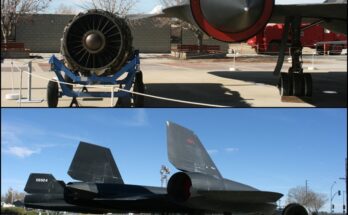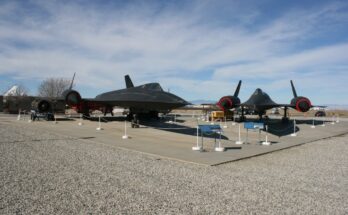
The Lockheed SR-71 Blackbird stands as one of the most remarkable achievements in aviation history. Designed during the Cold War, it was a symbol of American technological superiority and intelligence-gathering capability. Developed by Lockheed’s secretive Skunk Works division under the leadership of Clarence “Kelly” Johnson, the SR-71 first flew in 1964 and entered service with the U.S. Air Force in 1966. Its primary mission was reconnaissance—flying faster and higher than any enemy threat could reach. More than fifty years later, its successor, the conceptual SR-72 “Darkstar,” carries forward that legacy, combining speed, stealth, and unmanned capability for the modern era.
The SR-71 Blackbird was designed to outrun threats rather than evade them through stealth. It could reach speeds over Mach 3.2 (more than 2,200 miles per hour) and altitudes above 85,000 feet. At such heights, the curvature of the Earth was visible, and the aircraft could cover more than 2,000 miles in under an hour. Constructed primarily from titanium, the Blackbird had to withstand extreme heat generated by air friction at high speeds. Its distinctive shape minimized radar detection, making it one of the earliest aircraft to incorporate stealth design principles. Despite being developed with slide rules and hand-drawn blueprints, the SR-71’s performance remains unmatched by any operational aircraft to this day.
Operating the SR-71 required extraordinary skill and teamwork. It was flown by a two-person crew: a pilot and a reconnaissance systems officer. The pilot focused on navigation and flight control, while the officer managed the complex sensors and cameras that gathered high-resolution intelligence. Missions were often long and demanding, requiring in-flight refueling and careful route planning to avoid hostile airspace. The Blackbird’s speed meant that even if enemy missiles were launched, it could simply accelerate and climb beyond their reach—a strategy that kept the aircraft unscathed throughout its career.
As technology advanced, Lockheed Martin began exploring a successor that could surpass the SR-71’s capabilities. This led to the concept of the SR-72 “Darkstar.” First revealed in 2013, the SR-72 is envisioned as a hypersonic aircraft capable of speeds up to Mach 6—twice the speed of the Blackbird. Unlike its predecessor, the SR-72 is expected to feature unmanned or optionally piloted operation, relying on cutting-edge artificial intelligence and autonomous control systems. Its propulsion would use a turbine-based combined cycle engine, allowing it to transition seamlessly from jet propulsion to scramjet power at hypersonic speeds.
The SR-72 aims to fulfill modern military and intelligence needs by delivering near-instant global reconnaissance and potential strike capability. Its design also supports the development of future hypersonic weapons and vehicles, serving as both a testbed and a deterrent. While much about the Darkstar remains classified, Lockheed Martin has confirmed that a demonstrator aircraft is under development and could take flight in the near future.
Together, the SR-71 Blackbird and the SR-72 Darkstar represent two eras of innovation. The Blackbird proved that speed and altitude could ensure survival and superiority. The Darkstar pushes that concept into the next generation—combining speed with stealth, autonomy, and hypersonic technology. Both embody the same spirit of ingenuity that defines Lockheed’s Skunk Works legacy: to imagine the impossible and then make it fly.


